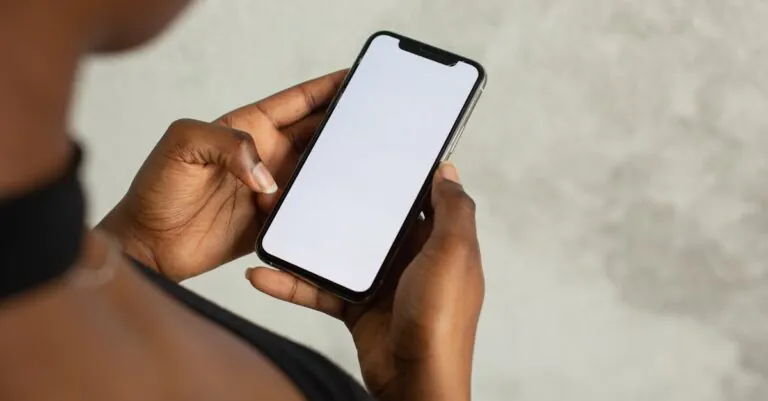In a world where Wi-Fi seems to play hard to get, smartphone tethering is like finding a secret stash of snacks during a diet. It’s the ultimate lifesaver for those moments when a reliable internet connection is nowhere to be found. Whether you’re stuck in a coffee shop with a weak signal or on a road trip with friends, tethering turns your phone into a mobile hotspot, letting you share that sweet data goodness with other devices.
Table of Contents
ToggleOverview of Smartphone Tethering Options
Smartphone tethering provides several methods for sharing mobile internet connections with other devices. Users commonly utilize three main tethering options: Wi-Fi hotspot, USB tethering, and Bluetooth tethering.
Wi-Fi hotspot settings allow users to transform their smartphones into portable routers. This method enables multiple devices to connect simultaneously, offering both convenience and flexibility. For instance, laptops, tablets, and other smartphones can access the internet through the host phone’s data connection.
USB tethering serves as a reliable alternative, especially for users who prefer a wired connection. By connecting a smartphone to a laptop with a USB cable, users minimize latency and enhance security. This method also ensures that the smartphone remains charged while tethered.
Bluetooth tethering offers a less common option, but it provides a practical solution for specific scenarios. This method consumes less battery compared to Wi-Fi tethering, making it suitable for short browsing sessions. Users can effortlessly connect devices via Bluetooth, creating a simple tethering solution for checking emails or messages.
Each option has its own advantages and may cater to different user needs. Wi-Fi hotspots offer greater versatility, while USB tethering is favored for stable connections. Bluetooth tethering stands out for energy efficiency when minimal data usage is required.
Overall, smartphone tethering options enhance connectivity in various situations, transforming how users access the internet on the go.
Types of Tethering

Smartphone tethering options enhance internet connectivity on the go. Understanding the various types helps users choose the best method for their needs.
USB Tethering
USB tethering provides a reliable connection through a physical cable. Users connect their smartphone to a laptop or tablet to establish a direct link to the internet. This method minimizes latency, ensuring stable performance for activities like video streaming or gaming. Additionally, it charges the smartphone while in use, eliminating battery drain concerns. USB tethering suits users who prioritize security and speed during online activities.
Wi-Fi Tethering
Wi-Fi tethering enables smartphones to serve as portable routers. Users can share their mobile data with multiple devices simultaneously, such as laptops or tablets. Setting up a Wi-Fi hotspot is typically straightforward, requiring only a few taps in the smartphone settings. This method often allows for greater flexibility, particularly in crowded areas like cafés or airports. Wi-Fi tethering benefits users needing to keep several devices connected without a wired option.
Bluetooth Tethering
Bluetooth tethering offers a convenient, though less common, way to share internet access. This method uses Bluetooth technology for short browsing sessions. It consumes less battery compared to Wi-Fi tethering, making it ideal for users needing minimal power consumption. While not as fast as USB or Wi-Fi options, Bluetooth tethering remains a viable choice for connecting a single device when necessary. Its energy efficiency makes it attractive for quick tasks on secondary devices.
Benefits of Smartphone Tethering
Smartphone tethering offers numerous advantages, especially when relying on Wi-Fi is not feasible. Users can enjoy enhanced internet access in various situations.
Increased Connectivity
Connectivity improves significantly with smartphone tethering. Individuals can share mobile data across multiple devices. During road trips, for instance, passengers can use their tablets for entertainment while the driver stays connected with navigation apps. Tethering transforms your smartphone into a mobile hub that supports laptops, smartwatches, and gaming consoles. Accessing the internet in remote locations becomes possible, making tethering an excellent option for outdoor enthusiasts. Users appreciate the ease with which they can switch between devices without interruption.
Cost-Effectiveness
Cost savings represent a vital benefit of smartphone tethering. Many users avoid purchasing additional data plans or portable Wi-Fi devices. Instead, they leverage existing mobile data allowances. For users who frequently travel, tethering eliminates the need for hotel Wi-Fi fees or cafe charges. Substantial savings can add up, especially when traveling for an extended period. Businesses also benefit, as employees can use tethering on their company-provided smartphones to access work emails and applications without incurring extra costs. Overall, smartphone tethering offers a practical solution for budget-conscious users.
Considerations When Using Tethering
Using smartphone tethering presents several important considerations that users should keep in mind. Ensuring optimal data management and safeguarding against security risks are crucial aspects.
Data Usage
Data consumption is a primary concern when using smartphone tethering. Users face potential overage charges if they exceed their mobile data limits. Monitoring data usage through settings or apps plays a key role in avoiding unexpected costs. Streaming videos or downloading files increases data consumption significantly, while browsing websites utilizes less data. Users should assess their mobile plan allowances before tethering. Engaging in high-data activities on multiple devices can quickly deplete data. Overall, understanding data limits and patterns enhances the tethering experience.
Security Risks
Security risks accompany the convenience of tethering. Unsecured connections invite potential vulnerabilities, making sensitive information susceptible to interception. Users must activate password protection on mobile hotspots to enhance security. Avoiding public Wi-Fi networks also contributes to reducing security risks. Regularly updating device software ensures that security patches are applied and vulnerabilities are addressed. Connecting only trusted devices lowers the risk of breaches. Awareness of security protocols and adopting safe practices fosters a more secure tethering environment.
Smartphone tethering options provide users with essential connectivity during critical moments. By transforming a mobile device into a hotspot users can ensure reliable internet access wherever they go. Each tethering method offers unique advantages catering to different needs whether it’s the speed and security of USB tethering or the flexibility of Wi-Fi.
As users navigate their tethering choices it’s crucial to remain aware of data limits and potential security risks. Adopting safe practices can enhance the tethering experience while maximizing the benefits. With the right approach smartphone tethering becomes an invaluable tool for staying connected in today’s fast-paced world.



